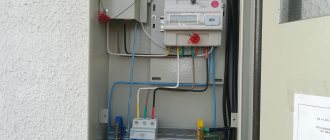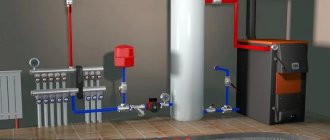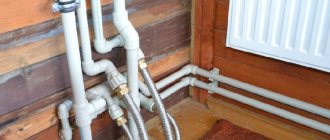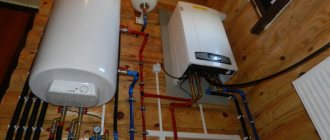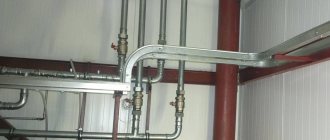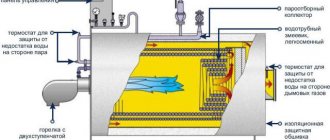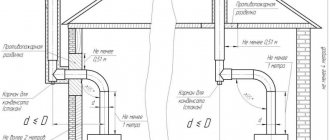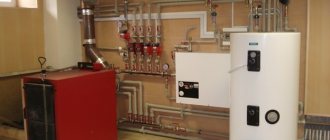Any person knows perfectly well that heating or central heating is created to provide comfortable living conditions. Many people know approximately the structure and how the central heating system generally works, as well as its standards.
To briefly recall, the heating process is carried out due to the thermal center, inside of which heat exchangers are located. Moreover, their location can be anywhere. For example, they can be placed in a boiler room, in a station, etc. Central heating is divided into several types: water heating, air and steam. But at the present time, combined heating is in greatest demand.
How is central heating arranged in an apartment building, and what are its differences with the central heating system of a private house?
Features of central heating in a private house
An agreement on the possibility of providing thermal energy, concluded between the supplier represented by the main boiler house and the owner of a private house (consumer), is a sufficient basis for connecting to the central heating network. There are three types of circuits for connecting the consumer to the main boiler room:
- Independent connection, in which a heat exchanger is used as a boiler. A similar scheme is used in cases where it is necessary to prevent an increase in pressure in the heating system provided for by the design of the building.
- Dependent direct-flow connection.
- The combined scheme provides for the supply of mixed water through a special elevator.
Regardless of the type chosen, work cannot begin without completing the accompanying documentation. Permission is issued by certain government bodies.
Common boiler room for the entire cottage community
An industrial heating network with its own staff plus constant state control.
Such “joint” heating functions more rationally than systems connected to the city heating network, where almost nothing depends on you. However: according to existing standards, a village heating network is considered industrial (and not at all private), and for its operation it is necessary to obtain licenses. Such a heating network must have permanent maintenance personnel who have permission to carry out work on the operation and repair of equipment and pipelines. In addition, constant monitoring is carried out by supervisory authorities, prescribed state inspections and other activities are carried out. All this is a “headache” for the administration and extra expenses for homeowners.
Images used in this article: carron.uk.net
Comment on FB Comment on VK
Also in this section
Heating is a complex system where general design decisions, correct pipe laying, and many other subtleties are important. Where might the reasons for the ineffective operation of the system be hidden?
The “Battle for Heat” has unfolded in Europe: the construction of energy-efficient houses. In “three-liter” houses for heating 1 sq. meter of area is enough for 3 liters of fuel per year. Fiction or reality?
We are used to apartments being connected to central heating. At the same time, the houses are heated with autonomous heating. But it happens that our private house operates with central heating. And this, of course, is a big problem, because there is a lot of pressure in the central heating system. Due to this pressure, home owners cannot use plastic pipes as there is a risk of rupture.
There is a high temperature in central heating, which, coupled with high pressure, also hangs like a threat over plastic pipes.
Central heating uses specially prepared water with the addition of various chemicals. And since the central heating system is also a hot water supply system, the water not only comes with different chemicals, but it also contains a large number of air bubbles.
Together, the chemistry and oxygen in the air bubbles destroy most radiators. This is why owners of houses connected to central heating can only use cast iron radiators, but they are not a panacea.
How would you like to mount, for example, steel, aluminum or copper-aluminum radiators, but you can’t. They are corroded less than during the heating season.
Also, due to the fact that there is a rapid construction of floors and these floors are connected to central heating, I often observe a picture of weak coolant circulation. Due to the fact that new houses with central heating are connected to old pipes, which, due to their throughput, are not designed for additional floors. By the way, these new floors themselves suffer from the same problems.
And if you live in a private house or apartment connected to central heating and don’t know how to protect yourself from thermal power plants and how to make sure that you can install good and modern radiators in your home and connect them with plastic pipes, hiding them in the walls, without fear their failure?
Read this article to the end and you will understand how to do it.
In my plumbing work, I often see houses connected to central heating and see how people suffer. I do my best to tell people how, using CHP, they can create autonomous heating in their home with their own low pressure, plastic pipes and beautiful modern radiators.
If it's warm outside, the CHP reduces the temperature. And if you have a north side, then your house is cool. We cannot influence this.
High pressure in the central heating system. We also cannot influence it, since the system is designed to operate at exactly this pressure.
We also cannot influence the chemical composition of the coolant from the thermal power plant, since the water undergoes special physical and chemical preparation before it enters the heating and hot water supply system.
The procedure for completing documentation for connecting to the system
The use of central heating in a private house requires prior approval from certain authorities. The registration process consists of the following stages:
- the relevant local authorities decide on the permissibility of installing a central heating system at a specific address;
- The supplier is obliged, at the consumer’s request, to provide a description of the connection conditions;
- preparation of technical documentation consists of developing a heating project with subsequent approval;
- The process is completed by concluding a contract for the supply of thermal energy.
Installing a central heating system in a private house without accompanying documentation is strictly prohibited. Domestic legislation provides for punishment for violators.
Permission from municipal authorities
An application submitted by the owner of a private house is subject to consideration at the next meeting by local executive or administrative bodies.
A positive decision is based on correctly completed technical documentation corresponding to the provided project. The result is reflected in the extract to the minutes of the meeting.
Provision of technical specifications by the heat supply organization
The consumer, represented by the owner of a private house, has the right to contact the energy supplier with a request. Representatives of the heat supply organization are required to review the application and provide the required information.
The supplier is given 14 working days to determine and issue technical conditions for connecting a private house to the centralized heating network. After the specified period, the operating organization either provides the requested documentation or substantiates the reason for the refusal.
Actions to develop and approve the project
For approval with the heat supply organization, a certain list of documents is provided. A properly compiled package contains:
- proposals for technical reconstruction of the previous heat supply scheme with detailed calculations;
- description of the method of thermal insulation of fencing devices separating the interior space of a private house from external structures;
- indication of the calculated thermal loads.
Photo 1. Diagram showing the movement of coolant in central heating from a heating point to a residential building.
To review the provided package of design documentation, a special commission is formed in the operating organization. In the absence of compelling reasons for refusal, approval takes place.
The metering unit project contains
- a) a copy of the heat supply agreement with attached statements of delineation of balance sheet ownership and information on design loads for existing facilities. For newly commissioned facilities, information about design loads or connection conditions is attached;
- b) plan for connecting the consumer to the heating network;
- c) schematic diagram of a heating point with a metering unit;
- d) plan of the heating point indicating the installation locations of sensors, placement of metering devices and cable wiring diagrams;
- e) electrical and wiring diagrams for connecting metering devices;
- f) a configuration database entered into the heat meter (including when switching to summer and winter operating modes);
- g) sealing diagram for measuring instruments and devices included in the metering unit;
- h) formulas for calculating thermal energy and coolant;
- i) coolant flow rate for heat-consuming installations by hour of the day in winter and summer;
- j) for metering units in buildings (optional) - a table of daily and monthly heat energy consumption for heat-consuming installations;
- k) forms of reporting sheets of meter readings;
- l) wiring diagrams for installing flow meters, temperature sensors and pressure sensors;
- m) specification of the equipment and materials used.
The diameter of the flow meters is selected in accordance with the calculated thermal loads in such a way that the minimum and maximum coolant flow rates do not go beyond the normalized range of the flow meters.
The equipment set includes mounting inserts to replace primary coolant flow converters and flow meters.
Project approval
The design of a metering unit installed at a thermal energy consumer is subject to agreement with the heat supply (heating network) organization that issued the technical specifications for the installation of metering devices.
The consumer sends a copy of the design of the heat metering unit to the heat supply (heating network) organization for approval. If the metering unit project does not comply with the provisions of paragraph 44 of Accounting Rules No. 1034, the heat supply (heating network) organization is obliged to send the consumer a notice of the provision of missing documents (information) within 5 working days from the date of receipt of a copy of the metering unit project.
In this case, the deadline for receipt of the metering unit project for approval is determined from the date of submission of the revised project.
The heat supply (heating network) organization does not have the right to refuse to approve the metering unit project if it complies with clause 44 of the Heat Energy Accounting Rules. In case of failure to provide information on approval or comments on the metering unit project within 15 working days from the date of receipt of a copy of the metering unit project, the project is considered approved.
The design of a thermal energy metering unit will be carried out in compliance with technical conditions, current regulations, rules, GOSTs and SNiPs. High quality workmanship guarantees its approval by the heat supply organization in the shortest possible time.
We will design heat metering units with high quality and in a short time with a guarantee of its approval by the resource supplying organization. This will help you proceed directly to the installation and commissioning of equipment, without wasting time waiting for a long time for a response from the heat energy supplier.
After the devices are installed, we can offer you a service for the thermal energy metering unit, which guarantees uninterrupted operation and quick troubleshooting if problems arise.
| Estimated prices for designing metering units | |
| Design of metering units | from 20,000 to 35,000 rub. (depending on the complexity of the node) |
How to carry out installation and draw up a contract
The final stage of the process of connecting a private house to a central heating system is the implementation of design work. Upon completion of the installation of heating, an agreement is concluded with the heat supply company. Such an agreement stipulates the conditions for the provision of services by the operating organization. The accompanying documentation attached to the contract contains detailed information about the heating system with a detailed description of all functional elements and their location.
Important! When installing heating equipment, certain safety measures must be observed. In particular, it is necessary to ensure free access to individual elements of the heating system. This will make it easier to replace or repair failed parts of heating equipment.
Features of an individual heating point
The dependent central heating circuit requires the presence of a specific transition device. Thermal energy is transferred through an elevator unit, which is part of the design of an individual heating point. In the central network, the water is heated to 150°C, while in the internal heating system the temperature is limited to a maximum value of 90°C. The lack of boiling is explained by increased atmospheric pressure in the pipes.
Thermal energy from the central network is transferred to the consumer using an elevator designed to heat the coolant. Mixing the internal system water with the superheated liquid from the main source causes the temperature to rise.
The elevator structure is made of steel casing. Inside there is a mixing chamber with a nozzle made in the form of a tapering hole. This device allows you to increase the speed of movement of the coolant in the heating system.
“Yes” or “no” to autonomous heating?
In many cases, there is simply no alternative to autonomous systems. This is especially true for areas where there are no well-developed engineering communications. In this case, you only need to choose the most suitable type of heating system, taking into account the cost-effectiveness and possibility of automating the process.
Installing an autonomous heating system may at first glance seem like a very complicated matter. It requires competent design and careful, flawless installation. That is why it is imperative to involve specialists to implement it.
For the success of the entire enterprise, it is enough to choose the right scheme and carefully monitor its condition during operation.
Did you find this article helpful? Please share it on social networks: Don't forget to bookmark the Nedvio website. We talk about construction, renovation, and country real estate in an interesting, useful and understandable way.
Central heating: pros and cons
The feasibility of choosing this heating method is determined by the proximity of the heating network mains. Owners who prefer such a system take into account the advantages of centralized heat supply to the premises, expressed by the following factors:
- the possibility of zonal distribution of thermal energy;
- high rate of heating of rooms;
- noiselessness;
- availability of equipment maintenance and repair.
When choosing a heating system for a private home, you should pay attention to the disadvantages of a centralized scheme:
- possibility of coolant leakage;
- the space for installing radiators reduces the usable area of the room;
- low air temperatures can cause the coolant in the pipeline to freeze;
- heat is distributed unevenly, depending on the proximity of the radiators.
The main disadvantage of the system under consideration is its dependence on the central network. A certain schedule for turning on the heating does not allow the owner of a private house to heat the room if necessary.
Each owner of a small private house or cottage must decide for himself how he will heat his home. There are two possible schemes here: organizing an autonomous engineering complex or connecting to external communications. The second method involves connecting to central heating, where the heat generator is located remotely. This system is generally similar to servicing an apartment building, but has several distinctive features.
To receive such utility services in the city, it is enough to pay bills on time. Heat is supplied without any documentation from the apartment owners. For owners of individual housing, this involves some hassle.
Preliminary calculation of connection fees
9.1. Preliminary calculation of fees for connection to the heat supply system of Omsk RTS JSC
| When the applicant selects a connection option after making the necessary changes to the Heat Supply Scheme of the city of Omsk and the investment program or if there is a technical possibility of connection | ||
| Consumer category | Connection fee, rub. without VAT | |
| without the construction of heating networks to the border of the land plot, or to the engineering and technical networks of a residential building | with the construction of heating networks to the border of the land plot, or to the engineering and technical networks of a residential building (channel-free underground installation) | |
| Connected load no more than 0.1 Gcal/h | 458,33 | 458,33 |
| Consumer category | Connection fee per 1 Gcal/h, thousand rubles. excluding VAT with direct connection from the heating networks of Omsk RTS JSC | |
| without the construction of heating networks to the border of the land plot, or to the engineering and technical networks of a residential building | with the construction of heating networks to the border of the land plot, or to the engineering and technical networks of a residential building (channel-free underground installation) | |
| Connected load more than 0.1 to 1.5 Gcal/h | 29,895 | 6110,257 |
| Connected load more than 1.5 Gcal/h if technically possible | 1,898 | 815,678 |
| Consumer category | Connection fee per 1 Gcal/h, thousand rubles. excluding VAT when connecting through the heating networks of an adjacent organization of the Omsk Municipal Heat Company "Heat Company" | |
| without the construction of heating networks to the border of the land plot, or to the engineering and technical networks of a residential building | with the construction of heating networks to the border of the land plot, or to the engineering and technical networks of a residential building (channel-free underground installation) | |
| Connected load more than 0.1 to 1.5 Gcal/h | 61,315 | 6141,677 |
| When the applicant chooses a connection option for a fee established individually, without making changes to the investment program and with subsequent introduction of appropriate changes to the Heat Supply Scheme of the city of Omsk in the prescribed manner | ||
| Consumer category | Connection fee, rub. without VAT | |
| without the construction of heating networks to the border of the land plot, or to the engineering and technical networks of a residential building | with the construction of heating networks to the border of the land plot, or to the engineering and technical networks of a residential building (channel-free underground installation) | |
| Connectable load regardless of size | REC of the Omsk region is installed on an individual basis | REC of the Omsk region is installed on an individual basis |
9.2. Preliminary calculation of fees for connection to the heat supply system of JSC "TGC-11"
| When the applicant selects a connection option after making the necessary changes to the Heat Supply Scheme of the city of Omsk and the investment program or if there is a technical possibility of connection | ||
| Consumer category | Connection fee, rub. without VAT | |
| without the construction of heating networks to the border of the land plot, or to the engineering and technical networks of a residential building | with the construction of heating networks to the border of the land plot, or to the engineering and technical networks of a residential building (channel-free underground installation) | |
| Connected load no more than 0.1 Gcal/h | 458,33 | 458,33 |
| Consumer category | Connection fee per 1 Gcal/h, rub. without VAT | |
| without the construction of heating networks to the border of the land plot, or to the engineering and technical networks of a residential building | with the construction of heating networks to the border of the land plot, or to the engineering and technical networks of a residential building (channel-free underground installation) | |
| Connected load more than 0.1 to 1.5 Gcal/h and more than 1.5 Gcal/h if technically possible | Not installed | Not installed |
| When the applicant chooses a connection option for a fee established individually, without making changes to the investment program and with subsequent introduction of appropriate changes to the Heat Supply Scheme of the city of Omsk in the prescribed manner | ||
| Consumer category | Connection fee, rub. without VAT | |
| without the construction of heating networks to the border of the land plot, or to the engineering and technical networks of a residential building | with the construction of heating networks to the border of the land plot, or to the engineering and technical networks of a residential building (channel-free underground installation) | |
| Connectable load regardless of size | REC of the Omsk region is installed on an individual basis | REC of the Omsk region is installed on an individual basis |
Central heating in a private house - what is it?
In itself, it is an extensive, large-scale complex through which coolant circulates from the energy supplier to consumers. It has the following structure
- central heating element. It serves as a thermal power plant or boiler house. In the first case, water is heated by steam generated by turbines. In the second, there is a high-power unit with a heat exchanger that runs on natural gas, fuel oil, etc.
- pipeline is the connecting link between the energy generator and the final links. Can be laid underground or above ground
- consumers: apartment buildings, schools, offices, etc. They distribute heat between individual devices - radiators, each of which is connected to a common line
Types of decentralized heat supply
Of course, building a separate boiler room, even a small one, is quite expensive. And the attic option is also not cheap. However, there is an alternative.
Modular boiler rooms
Block-modular boiler room
One of the very interesting projects is modular, or block, boiler rooms. There is no need to build anything, and only a small area is allocated for the boiler house. Blocks are brought here, which are easily and quickly connected into a finished structure
All of them are completed at the factory, the equipment inside them is precisely selected according to technical parameters, they are insulated and have a presentable appearance
The most important thing is to correctly configure and connect the equipment. A couple of days and the boiler room is ready
But only specialists should assemble it. If anyone remembers, such modular boiler houses were used to heat cabins and barracks, that is, temporary structures. After engineers and designers worked on them, such autonomous installations began to be used to organize heating in apartment buildings. However, this option is not the only one.
Wall boilers
The most effective and economical solution today is apartment heating, where wall-mounted boilers are used as a heating device. They run on either gas or electricity. Why wall-mounted?
Wall boiler
- Firstly, they are small in size, so they can be installed even in kitchens. At the same time, their appearance does not spoil the interior design at all.
- Secondly, wall-mounted heating boilers are real mini-boiler rooms. Their design includes a circulation pump, an expansion tank, as well as control and safety devices.
- Thirdly, such heating installations can have a power of up to 35 kilowatts, which allows them to heat rooms up to 100 square meters.
- Fourthly, modern manufacturers offer both single-circuit and double-circuit boilers for autonomous heating. So you will also be provided with hot water.
And now the important question is how to choose the right boiler? The main thing is to correctly select the unit according to its design features. It should contain all the devices we mentioned without exception - pump, tank, etc. In addition, it is necessary to have a chimney, which will ensure not only the removal of fuel combustion products in the case of gas boilers, but also the flow of clean air from the outside. This means that a wall-mounted gas boiler must have a closed combustion chamber. And the last thing is full automation, which will not only simplify the operation of the boiler, but will also save on fuel.
Of course, with gas boilers there are more problems when connecting. But electric analogues are simpler in this regard. Here you only need to draw a branch from the distribution panel with the installation of the machine and connect to the water supply system.
What might cause difficulties?
Modern kitchen
It may seem that everything is very simple and profitable. Then why don’t tenants switch to this heating system? And no one gives them permission. Imagine that the residents of one house will immediately submit documents for the re-equipment of heating networks, or rather, to refuse the services of organizations that supply heat to their houses. This is, firstly, a disaster for such an organization and deprivation of its profits. And, secondly, job cuts, although this issue is controversial. Someone needs to maintain autonomous mini-boiler rooms. So, in many respects, any of these options is not profitable for management companies. Although on a national scale, it’s the other way around. But it’s not for you and me to decide this issue.
Pros and cons of such a system
A private house with central heating also becomes a link in the chain - a consumer who can experience all the features of the complex’s functioning. Among its advantages for the user it is worth highlighting
- no need for repairs, maintenance, when the utility takes on all responsibility
- affordable cost of services
- reliability and uninterrupted supply of heat, when the supplier is obliged to turn on the centralized system strictly in accordance with the schedule and ensure immediate elimination of possible problems
On the other hand, these advantages can turn into disadvantages
- inability to regulate supply temperature
- dependence on on/off schedules
- unstable pressure in the pipeline, water hammer
- poor quality of coolant that clogs radiators with rust
Heating boilers
A forced heating scheme for a private house cannot do without heating equipment, which can be a boiler of one of the following types:
- Gas. The most common option. To install gas boilers, you need a main line, and the installation process is quite expensive. However, this is where the disadvantages end - gas-fired boilers are cheaper than all others to operate, and they do not require attention.
- Electrical. A less common and relatively inexpensive type of boiler. The biggest disadvantage of such devices is the cost of electricity and its consumption - ultimately, heating costs are prohibitively high.
- Liquid fuel. This is a fairly economical type of boiler, but it cannot be called a leader in this parameter. Diesel oil is usually used as fuel, which, on the one hand, is relatively inexpensive, but on the other hand, it will have to be topped up periodically, so it will be impossible to leave the boiler unattended.
- Solid fuel. Such boilers are inexpensive, and the cost of solid fuel (coal, firewood and pellets) is relatively low. Of course, to maintain the operating temperature, you will have to constantly add a new portion of fuel - that is, solid fuel boilers are quite inconvenient to operate.
In order for the heating scheme of a private house with forced circulation to be sufficiently effective, it is necessary to calculate the required boiler power at the design stage.
It would be best to turn to specialists, but if you really want to, you can do this work yourself - for example, using an online calculator. There is also a technique that allows you to calculate the approximate value of the power, according to which, for heating every 10 sq.m. the premises require 1 kW of thermal energy. Date: September 25, 2022
How the system works
The centralized heating of a private or apartment building operates using the same technology. The consumer is connected to a network of pipelines coming from the energy generator and turns into a heating point. To be able to cut off from the common main, it is equipped with a gate valve at the inlet. After it, a mud filter is inserted, trapping insoluble impurities.
Next, it is necessary to install a special device - an elevator, which simultaneously performs the functions of a circulation pump, mixer and thermostat. The fact is that water comes from a centralized boiler house or thermal power plant at a temperature of 130-150 C; it does not boil only because of high pressure. In order not to destroy the radiators, it must be cooled to 90 C by mixing in a cold jet. This is what the elevator is responsible for.
In addition, at its outlet there is a narrow nozzle, through which the coolant exits acquires additional acceleration for rapid movement through the pipes and prompt heating of buildings.
The impossible is possible
So is it possible to refuse central heating in a city apartment, despite such compelling counterarguments? Yes, but with certain restrictions.
Collective shutdown
The current housing legislation still provides for the transition to autonomous heating, but only for the whole house or (if there are several elevator units in the house) an entrance. The elevator is either completely disconnected from the heating main, or (if it has hot water supply connections) is cut off from the heating circuit with the valves shut off using pancakes and the flanges sealed.
How to refuse heating in an apartment with a house or entrance?
Here are short instructions for this quest.
- A general meeting of residents is held. The result of the meeting is recorded in the minutes.
The protocol is certified by the signatures of all residents.
- A conciliation commission is created at the local government body, to which this protocol is submitted along with the application to disconnect the central heating system.
- If a positive decision is made, the commission gives the residents’ representative a list of organizations from which technical conditions for drawing up the project are required.
- Specifications are transferred to the design organization.
- Once the project is completed, it is accepted by each organization on the list. What kind of approvals are needed?
| Organization | Subject of agreement |
| Heating networks | No threats to the heating supply of part of the house or surrounding houses when a group of apartments switches to autonomous heating |
| Gorgaz | No overloads of gas lines during operation of gas heating boilers |
| Energy company | No overloads of power supply lines when switching to electric heating |
| Department of Architecture | No damage to buildings that are architectural monuments when installing coaxial pipes for air intake and exhaust of combustion products |
| Housing organization | Technical feasibility of stopping centralized heat supply, absence of threats to load-bearing structures |
If your house is a listed building, you will probably be refused.
- After the project is accepted, it is transferred to a licensed organization to carry out the work.
- After their completion, the result is again accepted by representatives of all interested organizations.
Individual shutdown
Is it possible to refuse heating in an apartment individually, regardless of neighbors? Relatively recently, a loophole appeared in the legislation that allows this to be done, despite the active opposition of local authorities. Its existence has already been confirmed by several court decisions in favor of residents.
The Law of the Russian Federation “On Heat Supply” (Article 14, paragraph 15) uses the following wording: “The transition to an individual heating scheme using heat sources, the list of which is determined by the current connection rules... excluding cases arising from the heat supply scheme,” is prohibited.
The full text of the law can be easily found in a bookstore or online.
The list itself (of course, not specific models of equipment, but requirements for them) is contained in Resolution No. 307 of April 6, 2012 (clause 44).
According to the decree, the use of boilers that do not meet the following requirements is prohibited:
- The gas boiler burner must be closed. The air intake must be organized from the street.
- The boiler must have protection against overheating of the coolant and against gas leakage when the burner flame goes out.
- The operating temperature in the water heating circuit during boiler operation should not exceed +95C, operating pressure – 1 MPa.
Finding a device that meets these conditions is not a problem.
It is worth proving that the boiler you purchased satisfies all the above conditions - and the refusal to switch to individual heating will be recognized by any court as having no legal force.
What to do after receiving a court decision? The answer can be found in the Housing Code (clause 25, clause 26). IN
The conciliation commission is provided with:
- Application for refusal of central heating.
- Housing registration certificate.
- A document certifying ownership.
- Written consent of family members to refuse the CO.
- Pre-obtained permission from the Department of Architecture.
- Detailed design of individual heating and a diagram for changing central heating communications in your apartment.
After receiving permission, all that remains is to submit an application to the local housing organization and pay for the dismantling of the heating devices. Jumpers are installed instead of batteries. This is where your love affair with district heating ends.
The heater has been cut off. It remains to muffle the eyeliners.
Is it worth connecting central heating in a private house?
None of the experts will answer this question, since it depends on many external conditions. To assess the correctness of this decision, it is necessary to calculate the cost of arrangement and operating costs. It is worth considering the following factors
- degree of remoteness of heating networks from the consumer
- condition of the utility pipeline, degree of contamination
- level of service quality, a conclusion about which can be drawn based on a survey of other users
- costs associated with connecting to central heating: restructuring the heating system of a private house, drawing up and approving a project, collecting documentation, etc.
If the decision to connect to the communal heating complex has been made, a number of formalities must be completed.
Electric boilers
Electric boilers currently rank first in efficiency, since the efficiency of almost all models is at the level of 99%.
Moreover, which is very important, the organization of smoke removal and ventilation systems is not required. There is practically no need for maintenance of electric boilers, except for cleaning the equipment approximately once every 2-3 years
It is not difficult to implement an electrical heating circuit for a private house with your own hands: the degree of automation here can be of any degree. Strictly speaking, after proper installation, you can simply forget about the boiler.
How to make a connection
This process consists of a number of stages
- The owner draws up a project for a future heating system, containing a detailed plan for the reconstruction of the existing autonomous network in accordance with the requirements of the supplier. The documentation also includes an accurate calculation of thermal loads and a description of the method of thermal insulation of the building.
- The assembled package is submitted for approval to a special public utilities commission. If its participants have no comments, the project is approved.
- Permission to connect to central heating is issued by the local executive authority based on an application from the owner of the house. The decision is made after reviewing all the documentation provided by him.
- At the final stage, an agreement is concluded between the owner and the heat supplier.
General provisions
In accordance with the Federal Law “On Heat Supply,” consumers of thermal energy, including developers planning to connect (technological connection) to the heat supply system, enter into agreements on connection (technological connection) to the heat supply system and pay a connection fee (technological connection) to the system heat supply.
If there is a technical possibility of connecting (technological connection) to the heat supply system and if there is free power at the corresponding connection point (technological connection), a refusal to the consumer, including the developer, to enter into an agreement for connection (technological connection) of a capital construction facility located within the boundaries of a certain heat supply scheme within the radius of effective heat supply is not allowed.
In the event of the technical impossibility of connecting (technological connection) to the heat supply system of a capital construction facility due to the lack of free capacity at the corresponding connection point (technological connection) at the time of application by the relevant consumer, including the developer, but if there is a heat supply organization in the duly approved investment program or heating network organization of measures to develop the heat supply system and remove technical restrictions that make it possible to ensure the technical possibility of connecting (technological connection) to the heat supply system of a capital construction facility, refusal to conclude an agreement for its connection (technological connection) is not allowed.
The standard terms for its connection (technological connection) to the heat supply system are established in accordance with the investment program of the heat supply organization or heating network organization within the standard terms for connection (technological connection) to the heat supply system.
In the event of the technical impossibility of connecting (technological connection) to the heat supply system of a capital construction facility due to the lack of free capacity at the corresponding connection point (technological connection) at the time of application by the relevant consumer, including the developer, and in the absence of a heat supply organization in the duly approved investment program or heating network organization of measures to develop the heat supply system and remove technical restrictions, allowing for the technical possibility of connecting (technological connection) to the heat supply system of this capital construction facility, the heat supply organization or heating network organization within the time frame and in the manner established by the rules for connection (technological connection) to heat supply systems approved by the Government of the Russian Federation is obliged to contact the federal executive body authorized to implement state policy in the field of heat supply, or the local government body that has approved the heat supply scheme, with a proposal to include in it measures to ensure the technical feasibility of connection (technological connection) to the heat supply system of this capital construction facility. The federal executive body authorized to implement state policy in the field of heat supply, or the local government body that has approved the heat supply scheme, makes a decision on the making changes to the heat supply scheme or refusing to make such changes to it.
In the event that the heat supply or heating network organization does not send within the prescribed period and (or) submits in violation of the established procedure to the federal executive body authorized to implement state policy in the field of heat supply, or the local government body that approved the heat supply scheme, proposals for inclusion in following the relevant measures, the consumer, including the developer, has the right to demand compensation for losses caused by this violation, and (or) apply to the federal antimonopoly body with a request to issue an order to the specified organization to stop violating the rules of non-discriminatory access to goods.
How to properly connect a centralized system
For this, three standard schemes are used, the choice of one of which depends on the individual operating conditions, external parameters and other nuances.
- Independent. It is used when the increase in pressure in an autonomous complex is unacceptable, for example, the pipeline is assembled from polymers. To protect it from destruction due to water hammer and exposure to high temperatures, a heat exchanger is installed, acting as a boiler. It is also necessary to introduce a circulation pump and an expansion tank into the system. It is filled from the water supply or return water from the utility network.
- Combined with the installation of an elevator. In this case, a private house with central heating turns into a heating point and functions according to the scheme described above.
- Dependent. The easiest method to implement involves direct connection of the internal heating system to the centralized one. In this case, she must be prepared for difficult working conditions. The use of control valves and polymer pipes that are sensitive to water hammer is unacceptable.
Development of a water collection scheme
You need a water supply diagram in an apartment first of all for yourself, so as not to get confused, not to miscalculate and then to know exactly where everything is - no special permission is required for this work. But when registering the meter, the water utility inspector may ask to look at the diagram, so you need to draw it correctly.
Complete water supply diagram for a private house
A complete scheme according to all the rules is a serious job for a knowledgeable specialist; for example, in the large picture there is a water supply diagram for a private house with a summer kitchen, which is necessary for the project to be approved. But to replace pipes in an apartment, you don’t need to bother so much; it’s enough that the diagram is clearly visible and understandable:
- Hot and cold water pipes, their type and lumen diameter.
- Metering devices.
- Emergency valves and drains.
- Shut-off valves.
- Parsing points indicating consumers.
- Backup branches and devices.
- Direction of water flow.
In order for all this to be clear not only to yourself, or to yourself a year later, certain rules must be followed when drawing. Let's look at examples, see Fig. On the left - more or less ok, but with some comments, on the right - incorrect:
Simplified water collection diagrams with ERRORS
- The diagram on the right is made in isometry - for beauty, or what? The intersections of the pipes confuse her, and she does not give an idea of the actual location of the analysis points: the washing machine and the boiler come out under the floor.
- There are also too many arrows indicating current where it is already clear where it flows, which also confuses the diagram.
- In the same place, shut-off valves with metering devices are depicted unclearly and not according to the rules.
- There, the type and diameter of the pipes are not indicated.
- In the same place - who, where and when saw that water was supplied to the boiler from above, and the toilet was flushed through the low tide?
- But in the diagram on the left, it is clear even to a non-specialist that the boiler (6) is a backup one. The comment will be: “Where is the check valve when it’s hot? Without it, when the supply stops, the boiler will drive itself into a hot riser if valve (10) is not closed.” But this is essentially the case and with full understanding.
Correct simplified diagram of plumbing in an apartment
An example of an arbitrary, not according to the rules for drawing up design documentation, but a completely clear and no-nonsense water collection scheme is shown in the following figure. This is also an example of parallel water withdrawal; where the combs are, it’s clear.
Connection cost
It is quite difficult to name the exact amount of expenses for the implementation of this task, since it consists of a number of points: utility tariffs, reorganization of the existing heating system, purchase of additional materials. Connection prices vary significantly across regions of our country, and average indicators do not provide specific information.
To install central heating in a private house, it is necessary to calculate the cost of materials individually, based on the condition of the existing complex, its readiness to come into contact with aggressive coolant coming from a common boiler room or thermal power plant.
One thing is certain. Despite the initial costs incurred, heating through this system will ultimately cost the owner less than maintaining an autonomous network in working order and the constant costs of purchasing fuel.
Hello.
Technical specifications have been received from the management company for connection to public water supply and electricity networks. How to connect to the networks (hot and cold water risers are located in the purchased premises) if common property is not affected?
You yourself write that you have received technical conditions for connecting to common house networks (that is, common property), which the law includes risers for cold and hot water supply. Also, the composition of the common property of an apartment building in order to fulfill the obligation to maintain it can be determined by the owners of the premises in such a building by a decision of the general meeting and enshrined in the management agreement. As a conclusion, the consent of the owners of the apartment buildings is required
5. The composition of the common property includes in-house engineering systems of cold and hot water supply, consisting of risers, branches from the risers to the first disconnecting device located on the branches from the risers, the specified disconnecting devices, collective (common house) cold and hot water metering devices, first shut-off devices - control valves on the outlets of intra-apartment wiring from risers, as well as mechanical, electrical, sanitary and other equipment located on these networks.
(as amended by Decree of the Government of the Russian Federation dated May 14, 2013 N 410) The composition of the common property includes an in-house engineering drainage system, consisting of sewer outlets, fittings (including bends, transitions, pipes, audits, crosses, tees), risers, plugs, exhaust pipes, drain funnels, cleanouts, branches from risers to the first butt joints, as well as other equipment located in this system. (paragraph introduced by Decree of the Government of the Russian Federation dated 06.05.2011 N 354)
<Letter> of the Ministry of Construction of Russia dated 04/01/2016 N 9506-АЧ/04 <On the issue of classifying the heating elements of the heating system located inside the premises of apartment buildings as the common property of the owners of the premises of apartment buildings>
It is indicated that, according to paragraph 6 of the Rules for the maintenance of common property in an apartment building, approved by Decree of the Government of the Russian Federation of August 13, 2006 N 491, the common property includes an intra-house heating system, consisting of risers, heating elements, control and shut-off valves, collective (common house) thermal energy metering devices, as well as other equipment located on these networks. Thus, an in-house heating system is a set of risers, heating elements, control and shut-off valves, a collective (common house) heat energy meter, as well as other equipment located on these networks. According to the position of the Supreme Court of the Russian Federation, equipment located in an apartment building can be classified as common property only if it serves more than one residential or non-residential premises. Heating elements (radiators) of an intra-house heating system serving only one apartment, including those having shut-off devices (shut-off valves), the use of which will not entail a violation of the rights and legitimate interests of other owners of the premises of an apartment building, are not included in the common property. At the same time, it is indicated that the composition of the common property of an apartment building in order to fulfill the obligation to maintain it can be determined by the owners of the premises in such a building. A certain composition of the common property of an apartment building in respect of which management will be carried out is an essential condition of the agreement for the management of an apartment building, in connection with which the owners of the premises of an apartment building and the management organization in the management agreement for an apartment building by drawing up an appropriate annex to the agreement can delimit the area of operational responsibility according to heating system, placing responsibility for the heating elements (radiators) located in a residential (non-residential) premises and serving one premises on the owner of this premises, and responsibility for the risers, disconnecting devices on the branches of the risers, located in the owner’s premises, but serving several premises, - on the management company
The garage heating system includes important devices. On this website tab we will try to choose the right parts of the structure for your apartment. The heating system has pipes, fasteners, a connection system, air vents, manifolds, pressure-increasing pumps, batteries, boiler thermostats, and an expansion tank. These system components are undeniably important. Therefore, the choice of all parts of the structure must be made technically carefully.
Selecting a heating method
The owner of a private house, especially a new one, is faced with the question of how to properly install heating. One option is to connect to a centralized system. Central heating is a system in which the heat energy generator is a central boiler house independent of consumers. Consumers, including owners of private houses, can connect heating to the main heating network after concluding a heat supply agreement with the main boiler house. When the heating of a house is connected to the central heating network, three scheme options are used.
Diagram of a heating system with natural circulation.
- independent circuit;
- dependent scheme using mixed water through an elevator;
- dependent direct-flow circuit.
How to properly heat. There is little choice with central heating. An independent circuit uses a heat exchanger as a heat supply source, which performs the function of a boiler when the heating is individual. An independent scheme should be made when it is impossible to allow an increase in pressure in the house system for structural reasons. For example, if the system is made of plastic pipes, then heating according to an independent scheme is necessary. The circuit requires the use of a circulation pump. The heating system in the house can be filled either from the water supply or from the return pipeline of the heating plant through a special shut-off valve. An expansion tank needs to be installed in the system.
Bivalent hybrid heating systems based on heat pumps
A hybrid heating system (bivalent) consists of a main heat source, a peak heater and a buffer storage tank. This system allows you to use the heat pump as efficiently as possible with minimal investment.
Functioning of the bivalent system
As you know, heating equipment is selected according to the heat loss of the room at a minimum outdoor temperature (for Kyiv -22 ° C). This means that the selected boiler must heat your room in the temperature range: from -22 to +8 °C. If we analyze Climatology, it turns out that the number of days in the heating season when the temperature drops below -15 °C is less than 5%. Therefore, it is inappropriate to select a heat pump for the lowest possible outdoor temperature; it is much more profitable to purchase a heat pump of lower capacity and an inexpensive backup heat source (a peak heater - the cheapest electric boiler) that will be activated exclusively at temperatures below the bivalence point (usually -15 °C). The advantage of this system is also the redundancy of the heating system.
Main Pros:
- Heating system redundancy
- Possibility of purchasing a heat pump with lower heating capacity
Main Cons:
No
How much power does a heat pump need?
If you have a new house made of aerated block, insulated with 100-120-150 mm of mineral wool or polystyrene foam (walls and foundation to frost depth), good double-chamber energy-saving double-glazed windows, insulated roof (150-200 mm), insulated floor on the ground (minimum 100 mm), then the heat loss of your home is 50 W/m2 (at -22 °C):
- House 100 m2 – 5 kW
- House 150 m2 -7.5 kW
- House 200 m2 – 10 kW
- House 250 m2 – 12.5 kW
- House 300 m2 – 15 kW
- House 350 m2 – 17.5 kW
- House 400 m2 – 20 kW
- House 450 m2 – 22.5 kW
- House 500 m2 – 25 kW
- Building 1000 m2 - 50 kW
In principle, such body losses can be easily covered by an air-to-water heat pump of the Zubadan series:
- House 100 m2 – 5 kW – PUHZ-SW50VHA
- House 150 m2 -7.5 kW – PUHZ-SHW80VHA
- House 200 m2 – 10 kW – PUHZ-SHW112VHA/PUHZ-SHW112YHA
- House 250 m2 – 12.5 kW – PUHZ-SHW140YHA
- House 300 m2 – 15 kW – PUHZ-SHW140YHA + reserve 3 kW
- House 350 m2 – 17.5 kW – PUHZ-SHW230YKA
- House 400 m2 – 20 kW – PUHZ-SHW230YKA
- House 450 m2 – 22.5 kW – PUHZ-SHW230YKA + reserve 3 kW
- House 500 m2 – 25 kW – PUHZ-SHW230YKA + reserve 5 kW
- Building 1000 m2 - 50 kW - Cascade of 2 heat pumps PUHZ-SHW230YKA + reserve 4 kW
When choosing the power of a heat pump, you should also take into account the power required to heat ventilation, a swimming pool, hot water, etc. Therefore, before purchasing, consult an expert and perform a heat loss calculation.
Installation of an individual heating point
Scheme of central water heating.
In order to carry out central heating in a private house according to a dependent scheme, it is necessary to make a transition device. Such a device is an individual heating point with an elevator unit for transferring thermal energy. The water temperature in the central heating network can reach 150 °C, while in a house heating system it should not exceed 90 °C. The question may arise about non-boiling water at 150 °C. Thus, at 100 °C, boiling of water can occur only when the atmospheric pressure is normal. The pressure in the heating network pipes is high, so there is no boiling.
To transfer heat from the central heating network, a device called an elevator is used. The elevator unit, using an injection nozzle, accelerates the movement of water in the heating system of the building. The purpose of the elevator is to heat the water in the heating system of the house due to partial mixing with a small amount of superheated water from the central heating network. The elevator body is made of steel and has a mixing chamber inside with a tapering hole - a nozzle. The speed of water leaving the nozzle is very high and this movement causes water to move quickly in the heating system of the house. A constant vacuum is created behind the jet. Cooled water from the return part of the heating system enters this rarefied space.
By changing the flow cross-section of the nozzle device, you can control the amount of hot water flow. The flow cross-section is changed by blocking part of the nozzle hole with a “needle”. The needle is a cone with a slight angle at the apex. This cone moves using a rack and pinion mechanism, the control handle of which is moved outward. Proportional to the flow of water passed through the nozzle, the heating rate of the coolant in the home heating system changes. In general, the elevator functions as a pump, mixer and temperature controller at the same time. Elevators are trouble-free and silent, so this scheme has become widespread.
Wiring diagram for a heating system in a residential building.
The simplest in design and maintenance is the dependent direct-flow circuit. In the system, except for pipes and radiators, there are no additional elements: pumps, mixer, expansion tank. The system must ensure the safety of elements at high temperatures and high pressure. The disadvantage of this scheme is the complete dependence of the thermal regime inside the house on the central boiler room. With this scheme, plastic pipes cannot be used.
For indoor comfort and in order to save thermal energy, an individual heating unit should be equipped with additional devices. This is a regulator that sets the heating mode depending on the weather outside. For this, air temperature sensors installed outside and in one of the rooms of the house are used. Two water temperature sensors monitor the input and output of the heating system. The parameters from the sensors enter the electronic temperature controller, and it generates and sends a command to the stepper motor. This motor controls a two- or three-way valve and moves the elevator "needle" to the desired position.
A system with an elevator heating unit is the most suitable, since adjustment is made without the participation of a pumping pump.
More recently, the concept of central heating was the only one that meant comfort and warmth in the house without any problems. It seems to me that everyone still remembers how even residents of the private sector of cities heated their homes with wood and coal, and central heating was the ultimate dream for many. Utility networks did not reach all areas, and neither did gas lines. That’s why so many people wanted to get small apartments, and despite this drawback, they were welcome, because they had all the amenities, and most importantly, the warmth that comes to the house itself.
Central heating at home has huge advantages. Its use allows you to do without additional design documentation for a private house, and, of course, its installation, which causes many problems, from the design stage to the work of gas service installers, whose work is not very expensive. Bringing gas into the house is a whole epic of running around the authorities, and if you take into account the price of gas supply and heating installation, then all this results in a large expense item. Central heating saves us from many problems, primarily those related to home improvement; there is no need to allocate space for the boiler, no additional measures are required, and the only thing that remains is to enjoy the warmth and peace of a cozy home.
But there are also many significant factors that force citizens to go through all the circles of hell to design, purchase an individual heating boiler, install and pay for all services and change the central heating of the house to individual heating. And all because the central, in addition to its advantages, also has its advantages, which often outweigh all the good things.
The first disadvantage is the inability to regulate the heat supply, especially if your system does not have heat meters, as a result, even on warm days, when the weather permits and you reduce the heat supply using a valve, you will have to pay in full.
The second disadvantage is the strict start and end dates of the heating season. Freezing in the fall, you will wait helplessly for the 1st or 20th, or some other October, and the long-awaited warmth will appear in your home.
The third disadvantage is the price. It is calculated by square meters, again in the absence of heat meters, and spreads over the entire year, even for months without heating, otherwise most citizens simply will not be able to pay for boiler room services financially.
And if we take into account that even many apartment residents are happy to switch to individual heating, is it necessary to deprive yourself of comfort while living in a private house and regulate it yourself and pay significantly less at the same time?
Indoor heating devices and temperature conditions
The type of batteries installed in apartments depends on the year the building was constructed. If it was built in Soviet times, then the apartments will use one of the following types of radiators:
- metal convectors, which have a steel body, inside of which there are coils of DU-20 pipes and connected by a cross section;
- cast iron sectional batteries, which not only weigh a lot, but also have high heat transfer. Each radiator provides up to 150 W. Their disadvantages include the risk of leaks and unattractive appearance.
The dimensions of radiators or compartments in them depend on what floor the apartment is located on and what type of coolant circulation in the house. For example, if it is upper, then the coolant, reaching the first floor, will lose its temperature. It turns out that in order for the heating of an apartment building to be productive, in an apartment, if it is located on the ground floor, it is necessary to increase the number of compartments or install large radiators.
In modern multi-storey buildings, bimetallic radiators are usually installed. But this is the case if the heating system is water.
Such radiators are made of aluminum and have good heat dissipation, which is about 200 W per battery. But the price of such batteries is high. But the efficiency is great. Many people ask the question whether it is necessary to install bimetallic radiators or not. Everyone must answer this question for themselves, deciding for themselves whether they are willing to spend money to obtain heat.
The temperature regime in the apartments is indicated in the existing SNiP regulations. With central heating it is:
- bathroom – 25 degrees;
- living rooms and bedroom – 20 degrees;
- kitchen - 22 degrees;
- corner rooms - 22 degrees.
We recommend: How to write a refusal of central heating in favor of individual heating?
The maximum water temperature in the heating system pipes is also set. It should not be higher than 95 degrees. Centralized heating of an apartment building allows you to efficiently heat the room, but at the same time, the temperature in the apartment completely depends on the operation of the boiler room and other external factors. In this, this system is completely inferior to autonomous heating, which is devoid of this disadvantage.
